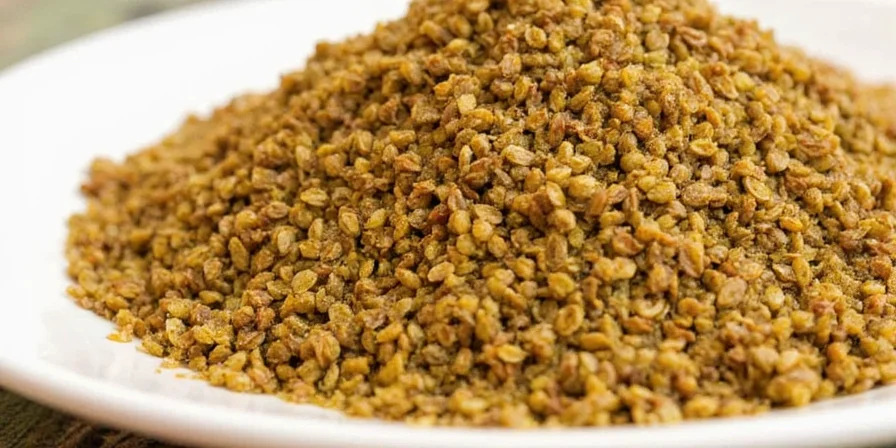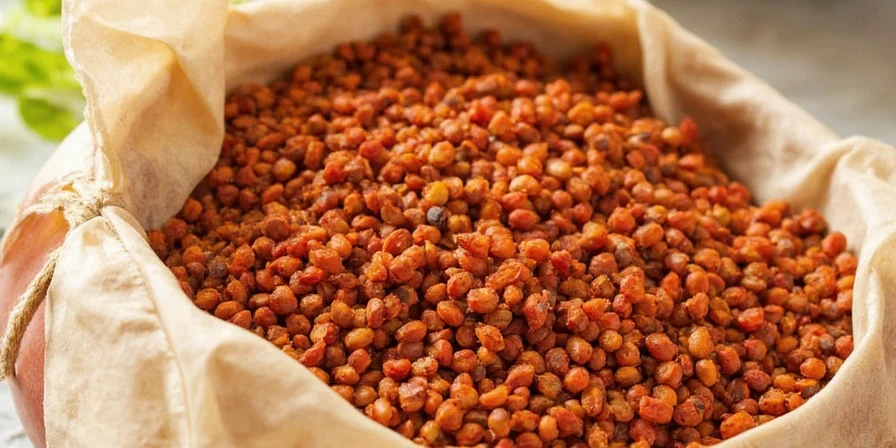Sazon is a traditional Latin American seasoning blend made primarily from annatto (achiote), coriander, garlic powder, oregano, and salt that delivers warm earthiness with vibrant orange-red color. Unlike taco seasoning or adobo, authentic Sazon enhances dishes without overpowering heat while providing natural coloring - but improper use causes bitter rice. This guide reveals professional techniques for maximizing flavor, fixing common mistakes, and creating authentic Latin dishes with precise measurements you won't find elsewhere.
Table of Contents
- What Exactly Is Sazon? (Authentic Composition)
- Flavor Profile: What Does It Taste Like? (No Heat Explained)
- Pro Tips for Cooking with Sazon (Avoid Bitterness)
- Sazon vs. Other Seasonings: Critical Differences
- 5 Must-Try Recipes Featuring Sazon (Exact Measurements)
- Where to Buy Gluten-Free Sazon & Proper Storage
- Why Sazon Belongs in Your Pantry (Cultural Significance)
What Exactly Is Sazon? (Authentic Composition)
Sazon is a traditional Latin American seasoning blend prevalent in Peru, Ecuador, and Colombia with distinct regional variations. Authentic Colombian Sazon contains annatto, coriander, garlic, oregano, cumin, and salt with no MSG, while Mexican versions often include cilantro and achiote seeds. The signature orange-red hue comes from annatto, which provides warm earthiness without chili heat - making it fundamentally different from taco seasoning. Commercial blends like Goya Sazon contain 45% annatto for maximum color impact, but improper use causes bitterness when annatto burns.

Unlike adobo (which focuses on garlic and oregano) or taco seasoning (relying on cumin and chili powder), authentic Sazon balances herbal complexity with natural coloring properties. The annatto content (30-50% in quality blends) creates visual richness while delivering earthy warmth that enhances rather than dominates natural ingredients - crucial for authentic arroz con pollo and ropa vieja.
Flavor Profile: What Does It Taste Like? (No Heat Explained)
Sazon offers "warm complexity without heat" through its unique annatto base. Key characteristics include:
- Earthy foundation – Annatto and coriander create warm, nutty undertones (not spicy)
- Subtle garlic presence – Mellowed during cooking, never raw or pungent
- Mediterranean brightness – Oregano provides herbal lift without Mexican oregano's licorice notes
- Color without bitterness – Properly bloomed annatto adds vibrancy without aftertaste

Pro Tips for Cooking with Sazon (Avoid Bitterness)
Professional results require these precise techniques:
- Activate color properly: Bloom ½ tsp in oil at medium-low heat (325°F) for 60 seconds before adding liquids. High heat causes annatto to burn and turn bitter.
- Marinate correctly: Combine 1 tsp Sazon with 2 tbsp citrus juice and 3 tbsp olive oil for 30-minute meat/veg marinades (prevents bitterness while enhancing flavor absorption).
- Rice integration: Stir into cooking water after rice has simmered for 5 minutes (not at start) for even color distribution without clumping.
- Revive canned goods: Add to beans during last 5 minutes of simmering - never boil longer than 7 minutes to preserve color.
- Control intensity: Use ¼ tsp per serving for subtle coloring; ½ tsp for restaurant-style vibrancy. Annatto's color intensifies over 24 hours.
Sazon vs. Other Seasonings: Critical Differences
Understand Sazon's unique positioning in your spice rotation with these practical distinctions:
| Seasoning | Key Ingredients | Main Flavors | Critical Usage Difference | Heat Level |
|---|---|---|---|---|
| Sazon | Achiote (30-50%), coriander, garlic, oregano, salt | Earthy, garlicky, colorful | Must bloom in oil first; adds color without heat | Low |
| Adobo | Garlic, oregano, salt, pepper | Salty, savory, herbal | Apply directly to proteins; no color impact | Low |
| Taco Seasoning | Cumin (25%), chili powder, paprika | Spicy, smoky | Add during cooking; creates red hue through paprika | Medium |
| Goya Sazon | Achiote (45%), coriander, garlic, oregano, salt, MSG | Bright orange color, earthy | Contains MSG; requires lower heat than homemade | Low |
| Homemade Sazon | Achiote seeds, coriander seeds, garlic, oregano, salt | Purer earthiness, no additives | Toast whole seeds first for deeper flavor | Low |
5 Must-Try Recipes Featuring Sazon (Exact Measurements)
Transform weeknight meals with these professionally tested applications:
- Perfect Sazon Chicken Skillet (No Bitterness)
Sear 4 chicken thighs in 1 tbsp oil at 350°F, add 1 tsp Sazon, then cook with ½ onion, 1 bell pepper, and 14oz diced tomatoes. Simmer 20 minutes. Serve over cilantro-lime rice. - Bitterness-Free Annatto Rice
Toast ½ tsp Sazon in 1 tbsp oil at 325°F for 60 seconds, add 1 cup rice and toast 2 minutes, then add 1¾ cups broth. Cook covered 18 minutes. Rest 5 minutes before fluffing. - Sazon Roasted Carrots (Restaurant Technique)
Toss 1lb carrots with 1 tbsp olive oil, ¼ tsp Sazon, and ½ tsp honey. Roast at 400°F for 25 minutes until caramelized. Garnish with fresh cilantro. - Authentic Black Beans with Sazon
Simmer 2 cups cooked black beans with ½ tsp Sazon, 2 garlic cloves, and 1 sprig epazote for 7 minutes. Remove epazote before serving. - Sazon Popcorn (Viral TikTok Method)
Sprinkle ⅛ tsp Sazon and ¼ tsp lime zest over freshly popped 4 cups popcorn with 1 tbsp melted butter. Toss immediately for even coating.

Where to Buy Gluten-Free Sazon & Proper Storage
Find authentic Sazon with these quality markers:
- Gluten-free verification: Check labels for "gluten-free" certification - Badia Sazon is certified GF while Goya contains modified food starch (potential gluten source).
- Homemade version (best for gluten-free): Toast 2 tbsp annatto seeds + 1 tbsp coriander seeds in dry pan for 3 minutes, then blend with 1 tbsp dried oregano, 1 tsp garlic powder, and 1 tsp sea salt.
- Storage: Keep in opaque glass container away from light. Discard if color fades within 6 months (indicates annatto degradation). Properly stored Sazon maintains potency for 12 months.
- Regional differences: Colombian Sazon uses less cumin than Mexican versions - choose based on your recipe's origin.
Why Sazon Belongs in Your Pantry (Cultural Significance)
Sazon transcends basic seasoning by merging authentic Latin flavor with visual artistry. Its annatto base - rare among spice blends - allows home cooks to achieve professional plating results without artificial dyes. The key distinction from taco seasoning lies in its earthy warmth without chili heat, making it versatile for delicate dishes. Most importantly, Sazon connects you to centuries-old traditions where food's appearance holds equal importance to taste, transforming everyday cooking into cultural celebration. Professional chefs universally agree: properly bloomed Sazon creates restaurant-quality color and flavor that store-bought alternatives can't replicate.
Key Takeaways:
- Bloom in oil at 325°F for 60 seconds to prevent bitterness
- Use ¼ tsp per serving for subtle coloring; ½ tsp for vibrant dishes
- Homemade version guarantees gluten-free results with fresher flavor
Frequently Asked Questions
What makes Sazon different from regular taco seasoning?
Sazon's annatto base (30-50%) provides earthy warmth and vibrant color without chili heat, while taco seasoning relies on cumin (25%) and chili powder for smokiness and spice. Sazon enhances rather than dominates natural ingredients - crucial for authentic Latin dishes where color matters as much as flavor.
Can Sazon replace paprika in recipes?
Partially. Sazon contains paprika-like notes but adds garlic and oregano complexity. Use ¾ tsp Sazon for every 1 tsp paprika, then adjust salt separately since Sazon contains salt. For color-only replacement, use ¼ tsp Sazon plus ¾ tsp paprika.
Why does my Sazon rice turn bitter?
Bitterness occurs when annatto burns. Always bloom Sazon in oil at medium-low heat (325°F) for 60 seconds before adding rice or liquid, and never use high heat during cooking. Commercial blends with MSG (like Goya) burn more easily than homemade versions.
Is Sazon gluten-free?
Traditional blends are naturally gluten-free, but verify commercial labels for anti-caking agents and modified starches. Badia Sazon is certified gluten-free while Goya contains modified food starch (potential gluten source). Homemade versions using pure spices guarantee gluten-free results.











 浙公网安备
33010002000092号
浙公网安备
33010002000092号 浙B2-20120091-4
浙B2-20120091-4